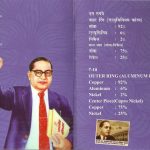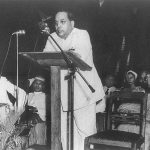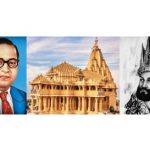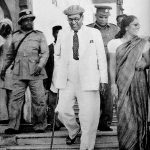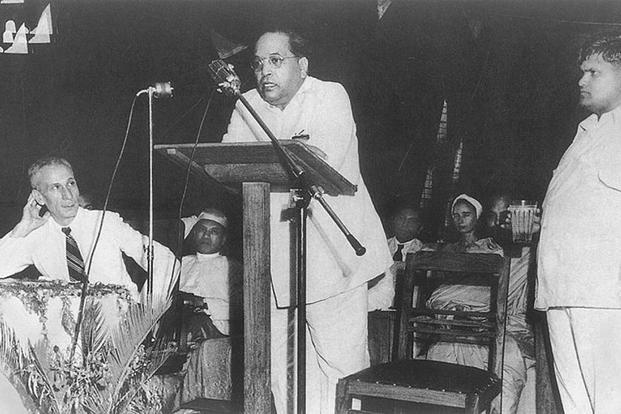
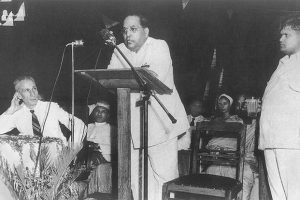
Dr Babasaheb Ambedkar was the Chairman of the Drafting Committee of the Constituent Assembly of India, which gave India the present Constitution. Though he was the Chairman of the Committee, he was not free to prepare the Draft of the Constitution according to his own ideas. He had the Government of India Act, 1935, before him, in addition to the reports of various committees appointed by the Constituent Assembly. Moreover, he was required to convince his colleagues on the Drafting Committee about the need of a particular provision in the Constitution.
Indian Constitution is a federal Constitution. An ideal federation is one in which the constituent units enjoy maximum autonomy consistent with the notions of unity of the nation. Moreover, such a federation is the result of a contract among the States which are independent. This happened in the United States of America. Thus, the federation in the USA was formed by the representatives of independent States. The Constitution thus formed was also later ratified by the legislators of the States, which were parties to the contract. In India, however, the makers of the Constitution merely picked up the idea from the Government of India Act, 1935 and introduced it in the Indian Constitution. It is an irony in India’s constitutional history, that the Government of India Act of 1935 (which was passed by the British Parliament), which the leaders of the Indian National Congress wanted to destroy, became the foundation of many of the articles of the Constitution adopted by the Constituent Assembly. According to the Government of India Act, 1935, the idea of federation was, to bring the British Indian Provinces and the Princes of Indian States together for a Constitution for the whole of India. The Princes accepted the idea because they believed that in such a federation, their interests would be safeguarded, as against popular revolt in their own States. The British Government accepted the idea as it believed that as against the elected representatives of the Indian National Congress, the Princes would vote with the British interest. Moreover, Indian Federation under the Government of India Act 1935, was imposed upon the States from above. It was not evolved from bottom to top as it happened in the United States of America. The framers of the Indian Constitution imposed the federation of Indian people.
A federal Constitution regulates the relations of the federal Government and the constituent units in administrative, legislative and financial spheres. Such regulations have to take care of the legitimate interest both of the federal Government and the constituent units and safeguard the limited autonomy of the constituent units. This is not an easy task. The impression that an impartial reader of the Constitution of India, gets, is that these provisions have conferred more powers on the federal Government at the cost of the constituent units. Some provisions of the Constitution have gone to the extent of even destroying the limited autonomy of the constituent units, in administrative sphere. This has happened in Article 356, which provides for President’s rule in the States. The background for the use of Article 356 is provided by Article 355 which reads as under:
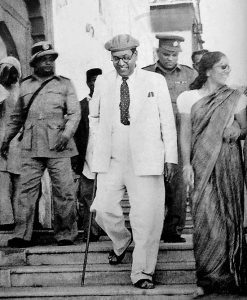
“It shall be the duty of the Union to protect every State against external aggression and internal disturbance and to ensure that the government of every State is carried on in accordance with the provisions of this Constitution.”
Thus, a duty is cast on the Union Government to protect every State. In jurisprudence, the concept of duty is linked with the concept of power or authority. No organ of a State or any individual would be able to fulfil the constitutional obligation cast on it, unless the Constitution also confers adequate powers on it for fulfiling the obligation. Dr Ambedkar explained the basis of Article 355 as under:
“Now I come to Article 277-A present Article 355. Some people might think that Article 277-A is merely a pious declaration that it might not to be there. The Drafting Committee has taken a different view and I should therefore like to explain why it is that the Drafting Committee feels that Article 277-A ought to be there.”
Dr Ambedkar observed:
“I think it is agreed that our Constitution, notwithstanding the many provisions which are contained in it whereby the Centre has been given powers to override the Provinces, nonetheless is a Federal Constitution and when we say that the Constitution is a Federal Constitution, it means this, that the Provinces are as sovereign1 in their field which is left to them by the Constitution, as the Centre is in the field which is assigned to it. In other words, barring the provisions which permit the Centre to override any legislation that may be passed by the Provinces, the Provinces have a plenary authority to make any law for the peace, order and good government of that Province. Now, when once the Constitution makes the provinces sovereign and gives them plenary powers to make any law for the peace order and good government of the Province, really speaking the intervention of the Centre or any other authority must be deemed to be barred, because that would be an invasion of the sovereign authority of the province. That is a fundamental proposition which, I think, we must accept by reason of the fact that we have a Federal Constitution. That being so, if the Centre is to interfere in the administration of the provincial affairs, as we propose to authorise the Centre by virtue of Article 278 and Article 278-A, it must be by and under some obligation which the Constitution imposes upon the Centre. The invasion must not be an invasion which is wanton, arbitrary and unauthorised by law.“2 (emphasis added)
“Therefore in order to make it clear that Articles 278 present Article 356 and 278-A Article 357 are not to be deemed as wanton invasion by the Centre upon the authority of the Province, we propose to introduce Article 277-A. As members will see, Article 277-A says that it shall be the duty of the Union to protect every unit, and also to maintain the Constitution. So far as such obligation is concerned it would be found that it is not our Constitution alone which is going to create this duty and this obligation. Similar clauses appear in the American Constitution. They also occur in the Australian Constitution where the Constitution, in express terms, provides that it should be the duty of the Central Government to protect the units or the States from external aggression or internal disturbance. All that we propose to do is to add one more clause that it shall be the duty of the Union to maintain the Constitution in the Provinces as enacted by this law. There is nothing new in this and, as I said, in view of the fact that we are endowing the Provinces with plenary powers and making them sovereign within their own fields it is necessary to provide that if any invasion of the provincial field is done, it is in virtue of this obligation. It will be an act of fulfilment of the duty and obligation and it cannot be treated so far as the Constitution is concerned, as wanton, arbitrary and unauthorised act.”3
It must be stated that the references to American and Australian Constitution are not appropriate in the context of Article 356. They may be appropriate in the context of Article 352 of the Constitution.
Article 356 of the Indian Constitution is similar to Section 93 of the Government of India Act, 1935. The Joint Parliamentary Committee on Indian Constitutional Reform (1933-34) explained the provisions in Section 93 where similar power to assume sole responsibility of administration of the Province had been conferred on the Governor in case of a breakdown of the machinery of the Provincial Government in whole or in part.
The Constituent Assembly was not happy with Article 278 present Article 356. Shri H.V. Kamath objected to the word ‘otherwise’ in the Article and observed:
“Reading all these Articles since yesterday and the amendment moved today, it seems to me that we are not going about the business in an honest fashion.”
Hence he moved an amendment to delete the word ‘otherwise’. In a hard hitting speech Mr. Kamath observed:
“This is a foul transaction, setting at naught the scheme of even the limited provincial autonomy which we have provided for in this Constitution, and I shall pray to God that He may grant sufficient wisdom to this House to see the folly, the stupidity and the criminal nature of this transaction.”
Mr. Kamath wanted the President to act only on the report of the Governor. He also pointed out that if the amendment was not accepted, ‘we are laying ourselves open to snare and traps in our path wherein we shall be caught beyond any rescue’.4 It must be admitted that Mr. Kamath proved to be prophetic. The Karunanidhi Ministry in Tamil Nadu was dismissed by President Venkataraman on the advice of Prime Minister Chandrashekhar, even when the Governor had not forwarded any report. Governor Barnala in a Press interview publicly stated that he had not sent any report to dissolve the Ministry and the Legislative Assembly.
Dr P.S. Deshmukh pointed out:
“My learned Friend, Dr Ambedkar, has quoted the American and Australian Constitutions in support of Article 278 present Article 356. Fortunately or unfortunately there is no mention of any emergency either in the Australian or American Constitution. He quoted them probably to show that there will be no encroachment from the Centre so far as the units are concerned …. If we mean this Constitution to work, the Centre will have to respect the autonomy of the provinces whether we specifically say so or not …. There was therefore hardly any point in the Honourable Doctor trying to derive support from foreign Constitution. It would have been some consolation if he could have cited an appropriate parallel to the whole scheme now unfolded for the first time. That he could not do. Here we are taking away all the powers of the Provincial Governors and Provincial Administrations; I do not think, Sir, this is wise or likely to work well or be in the interest of sound and beneficial administration.”
It is true that Sir Alladi also tried his best to defend these provisions.5 In defending the provisions Dr Ambedkar pointed out:
“… I would like to draw attention to the article contained in the American Constitution, where the duty of the United States is definitely expressed to be to maintain the Republican form of the Constitution. When we say that the Constitution must be maintained in accordance with the provisions contained in this Constitution we practically mean what the American Constitution means, namely that the form of the Constitution prescribed in this Constitution must be maintained.”6
With due respect to Dr Ambedkar, it must be stated that his explanation is unconvincing. As a Chairman of the Drafting Committee he had to defend and hence he defended. Dr Ambedkar was frank in his last comments on Articles dealing with emergency provisions. He observed:
“In regard to the general debate which had taken place in which it has been suggested that these articles are liable to be abused, I may say that I do not altogether deny that there is a possibility of these articles being abused or employed for political purposes.7 But that objection applies to every part of the Constitution which gives power to the Centre to override the Provinces. In fact I share the sentiments expressed by my honourable Friend Mr Gupte yesterday that the proper thing we ought to expect is that such articles will never be called into operation and they would remain a dead letter.8 If at all they are brought into operation, I hope the President, who is endowed with these powers, will take proper precautions before actually suspending the administration of the Provinces. I hope the first thing he will do would be to issue warning to a Province that has erred, that things were not happening in the way in which they were intended to happen in the Constitution. If that warning fails, the second thing for him to do will be to order an election allowing the people of the province to settle matters by themselves. It is only when these two remedies fail that he would resort to this Article.“9
(emphasis added)
The above passage indicates that Dr Ambedkar was not happy at the inclusion of Article 356 of the Constitution. But, as the Chairman of the Drafting Committee he had no option but to support the article. He even expressed a hope that such articles will never be called into operation and that they will remain a dead letter. He also pointed out that if at all the power was required to be exercised it should be done sparingly and the cause must be failure of constitutional machinery in a State. Dr Ambedkar was a born democrat. He believed in rule of law and democracy. He always insisted that rules of democracy must be based on fair play. Hence he said in the Constituent Assembly that the power under Article 356 must not be used by the Union Government for political purposes. However his hopes were dashed to pieces by all political parties that wielded power at the Centre. Naked abuse of this power was started when the Communist Government in Kerala was dismissed by Jawaharlal Nehru. This process of abuse of this article was clearly seen in recent use of this article by Narasimha Rao in case of States of Uttar Pradesh, Rajasthan, Himachal Pradesh and Madhya Pradesh.
The Indian Law Institute published a very informative book on President’s Rule in the States in 1978.10 It points out that in Nehru era there were six cases, in Lal Bahadur Shastri era two cases, in Indira Gandhi era twenty eight cases, in Janata rule twelve cases. The latest figure about the use of Article 356 is more than 86. In none of these 86 cases, the procedure mentioned by Dr Ambedkar was followed. It was reported in the press that the President Dr Shankar Dayal Sharma was reluctant to sign the Proclamation under Article 356 with respect to the States of Uttar Pradesh, Madhya Pradesh, Himachal Pradesh and Rajasthan in 1992. He was right in expressing his disapproval. But, it appears that he ultimately agreed to sign as he had no other option under the Constitution. In this behalf it is submitted that Dr Shankar Dayal Sharma should have asserted himself by inviting the attention of Prime Minister Narasimha Rao to what Dr Ambedkar has observed in the Constituent Assembly and advised him to act accordingly.11
In majority of the cases under Article 356 it was the intolerant and dictatorial attitude of the party in power at the Centre that was at the root of the use of Article 356. The Constitution does not provide a specific remedy against the abuse of power or mala fide use of power. However the Proclamation made by the President can be challenged in a Court of law. In fact there is a decided case12 of the Supreme Court on this and the Court laid down that if the satisfaction of the President is mala fide or based on extraneous or irrelevant grounds, the Proclamation would be justiciable. Having laid down this principle, the Court however did not strike down the Proclamation, for reasons best known to the Judges who delivered the judgment. For, in Rajasthan case12 the Proclamation was both mala fide and based on irrelevant grounds. In the case of the Proclamation issued in 1992 with respect to the States of Uttar Pradesh, Rajasthan, Madhya Pradesh and Himachal Pradesh, it is submitted that the Proclamation is based on irrelevant grounds and is also mala fide. It deserves to be struck down and the Court should also restore the dissolved assemblies and the ministries.13 The demon of Article 356 has been working havoc in the past. It is necessary to put chains on this demon. The best chain would be striking down the Proclamation in appropriate cases and restoring these dissolved assemblies and ministries and thus establishing the supremacy of the Constitution. I am sure that if Dr Ambedkar had been with us today he would have been very happy at such a judicial attitude.
- The view that Provinces (now States) are sovereign under the Indian Constitution was rejected by the Supreme Court of India in State of W.B. v. Union of India, AIR 1963 SC 1241. Return to Text
- Constituent Assembly Debates, Vol. IX, p. 133. Return to Text
- Ibid, p. 133 Return to Text
- Ibid., p. 148 Return to Text
- Id., p. 150-51 Return to Text
- Id. pp. 175-76 Return to Text
- Ambedkar’s vision saw the future. Return to Text
- Art. 356 was brought into operation on more than 80 occasions upto 1993. Return to Text
- C.A.D., Vol IX, p. 177. This warning as cautioned by Dr. Ambedkar was not resorted to even in a single instance. Return to Text
- President’s Rulein India, prepared by Rajeev Dhavan, 1979, N.M. Tripathi, Bombay Return to Text
- Debates in the Constituent Assembly are relied upon by the Supreme Court in deciding cases. Hence, it is submitted that the President of India would be justified in relying upon the debates in the Constituent Assembly. As already quoted above, Dr Ambedkar had clearly pointed out in the Constituent Assembly that before resorting to Article 356: “The first thing the President will do would be to issue warning to a province that has erred, that things were not happening in the way in which they were intended to happen in the Constitution. If the warning fails the second thing for him to do will be to order an election allowing the people of the province to settle matters by themselves. It is only when those two remedies fail that he would resort to this Article.” It is hoped that Presidents of India would not only study the Constitution of India, but they will also study the proceedings in the Constituent Assembly. During the Dr. Ambedkar birth centenary celebration period leaders of all political parties paid eloquent tributes to Dr Ambedkar. But many of them have behaved contrary to his views and warning sounded by him in his memorable speech delivered in the Constituent Assembly on November 25, 1949. It is suggested that some portions of that speech should be inscribed on marble stones which should adorn the gardens of Parliament House. Return to Text
- State of Rajasthan v. Union of India, (1977) 3 SCC 592: AIR 1977 SC 1361 Return to Text
- Such a course was adopted in Pakistan in one case. Return to Text
Author : T.K. Top
Cite as : (1993) 4 SCC (Jour) 1







